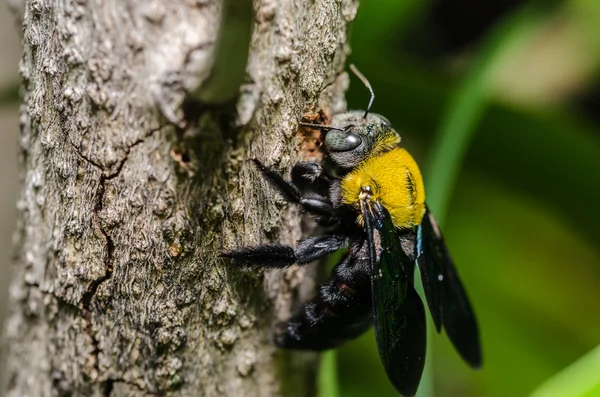Carpenter bees are frequently confused with bumblebees due to their similar size and fuzzy appearance. These solitary insects are notorious for drilling into wooden structures, especially untreated or exposed wood, to create nests. But a common question arises: do carpenter bees sting? This blog will answer that and provide a detailed look into carpenter bee behavior, potential risks, and ways to control carpenter bee infestations.
Do Carpenter Bees Sting?
Yes, carpenter bees can sting, but the situation is more nuanced. It’s important to distinguish between male and female carpenter bees. The female carpenter bee is the only one capable of stinging. However, she is generally docile and will only sting if she feels directly threatened or handled.
In contrast, male carpenter bees might seem more aggressive as they hover near people and defend their nests, but they are completely harmless. Unlike their female counterparts, males lack a stinger and cannot sting at all. So while their hovering behavior may be unsettling, it’s not a real danger.
In short, while carpenter bees are capable of stinging, they typically won’t unless provoked, and most of the time, the aggressive-appearing males are just bluffing.
What to Do If Stung by a Carpenter Bee
If you do happen to get stung by a carpenter bee, it’s likely from a female. The site of the sting may develop redness, swelling, and some discomfort, much like a sting from any other bee. For most people, the pain is mild and can be managed with ice, over-the-counter antihistamines, and pain relievers.
Source: Bees Wiki
However, if you experience symptoms like difficulty breathing, dizziness, or swelling of the throat or face, this could indicate a severe allergic reaction. In such cases, seek medical attention immediately, as these reactions can be life-threatening.
Carpenter Bee Behavior and Nesting Habits
Carpenter bees are solitary insects, which means they don’t live in large colonies like honey bees or bumblebees. Instead, individual female bees create nests in wood, boring into structures like decks, fences, and eaves of houses.
These bees are especially attracted to untreated wood. Left unchecked, their tunneling can lead to structural damage over time, making carpenter bee control a priority for homeowners. The damage starts with a small, circular hole that leads into a tunnel, where the bees lay their eggs.
How to Spot Carpenter Bee Infestations
Recognizing the signs of a carpenter bee infestation early can help prevent long-term damage. Here are some key indicators:
- Boreholes in wood surfaces, typically ½ inch in diameter.
- Piles of sawdust (frass) beneath these holes, a result of the bees tunneling into the wood.
- Stains near the holes, caused by the bees’ droppings.
- Male carpenter bees aggressively fly near wooden structures.
- Audible buzzing sounds in areas where the bees are active.
If you notice any of these signs, it’s important to act quickly to minimize damage.
Preventing and Controlling Carpenter Bees
While carpenter bees are important pollinators, their nesting habits can cause costly damage to your home if ignored. Here are several effective strategies to prevent carpenter bees from settling in and protect your wooden structures:
- Seal Exposed Wood: Carpenter bees are attracted to exposed and untreated wood. Applying paint or varnish to wooden surfaces like fences, decks, and eaves can make these areas less inviting to the bees.
- Fill Existing Holes: If you discover boreholes, fill them with wood putty or caulk to prevent the bees from reusing them in the future.
- Install Carpenter Bee Traps: There are specially designed traps available to catch carpenter bees, which can help reduce their presence without using harsh chemicals.
- Consult Pest Control: In severe carpenter bee infestations, contacting a professional pest control service is recommended. They can safely remove the bees and apply treatments that deter future nesting without harming the environment.
- Replace Damaged Wood: Over time, carpenter bee tunneling can weaken wood to the point where it needs replacing. If the wood has suffered extensive damage, replacing the affected areas is necessary to maintain structural integrity.
- Decoy Nests: Hanging decoy nests can trick carpenter bees into thinking a wooden area is already occupied, discouraging them from nesting there.
A Brief History of Carpenter Bees
Carpenter bees belong to the genus Xylocopa, with different species found across the globe. These bees have long been a part of ecosystems, serving an important role as pollinators. However, their tendency to nest in human-made wooden structures has caused a concern for homeowners. While these bees have historically been admired for their pollination abilities, their destructive tendencies in modern environments make them a nuisance for anyone with wooden structures.
Carpenter Bees and Health Risks
Although carpenter bee stings are rare, it’s wise to be cautious, especially if you are allergic to bee stings. Most people experience only mild reactions, such as localized pain and swelling. However, for those with allergies, being stung by a carpenter bee can trigger more severe symptoms, requiring prompt medical attention.
For non-allergic individuals, the sting of a carpenter bee poses minimal risk. Nevertheless, it’s always best to be mindful and monitor the site of the sting for any unusual symptoms, such as infection or excessive swelling.
Though carpenter bees can sting, the real concern they pose lies in the damage they can cause to wooden structures. Their nesting habits can lead to structural damage over time if left untreated. With proper prevention methods and timely carpenter bee control, you can protect your home from carpenter bee infestations. Remember, while these bees can be destructive, they’re also vital pollinators, so humane control methods are always the best option.
